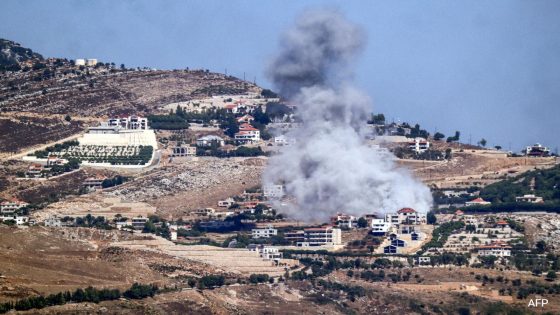Sign up for CNN’s Wonder Theory science newsletter. Explore the universe with news on fascinating discoveries, scientific advancements and more.
More than three weeks into a mission that was initially projected to last only days, the two astronauts piloting the inaugural crewed test flight of Boeing’s Starliner spacecraft do not know when they will return home.
Officials have repeatedly indicated that the Starliner — which encountered issues with helium leaks and thruster outages en route to the International Space Station in early June — will be safe to bring astronauts Suni Williams and Butch Wilmore home.
Still, Steve Stich, NASA’s Commercial Crew Program manager, said Friday that the space agency is considering extending the maximum length of Starliner’s mission from 45 days to 90 days. And there is no firm return date on the horizon.
Part of that desired extension is driven by ground tests that Boeing and NASA plan to carry out in New Mexico, seeking to better understand why some of the Starliner’s thrusters unexpectedly failed during the first leg of its journey. (Four of the five failed thrusters on Starliner have since been restored; however one thruster is not expected to work for the remainder of the mission.)
“We’re just looking at the timeline to execute (the test in New Mexico) and then review the data,” Stich said at a Friday briefing. “And that’s what’s really the long pole, I would say, determining a landing date.”
“We’re not in a rush to come home” he added.
Stich and Mark Nappi, vice president and program manager of the Commercial Crew Program for Boeing, also said Friday that engineers are still not yet certain about the root cause behind the Starliner’s problems.
Part of the goal of carrying out the ground tests while the vehicle is still in space, Nappi said, is to try to whittle down possible reasons the thrusters malfunctioned.
“So if (the test in New Mexico) comes back and gives us all the answers, then we can just undock and come home,” Nappi said. “If it comes back and says, ‘Here’s 80% of the answer. And if you just run one more docked hot fire (test on the Starliner in orbit), then you can get 100% of the answers’ — then we want (Starliner) to be there so that we can get that information.”
Meanwhile, Williams and Wilmore have integrated with the rest of the crew currently aboard the International Space Station and are carrying out routine tasks.
A start to a historic flight
Boeing Starliner’s troubles began wth its launch atop an Atlas V rocket on June 5.
The mission team detected a helium leak ahead of launch but didn’t consider it threatening enough to abandon takeoff.
When asked about that decision Friday, Nappi said he had “no regrets on the decision to launch and get into the test flight.”
He added that NASA and Boeing have always emphasized that this mission was a test flight, aiming to gather data to improve Starliner’s performance for future missions.
Setbacks in orbit
Several more helium leaks were identified while the craft was en route to the International Space Station along with the thruster issues. The problems occurred on the Starliner’s service module, a cylindrical attachment at the bottom of the spacecraft that provides much of the vehicle’s power during flight.
By design, the service module will not survive the trip back to Earth. The module is jettisoned and destroyed as the Statrliner spacecraft reenters the atmosphere. That’s why Boeing and NASA teams then chose to leave the Starliner spacecraft safely docked with the space station while they worked to learn as much as possible about those issues.
It’s not yet clear whether NASA will extend the maximum mission length to 90 days. Stich said officials must clear the Starliner’s battery life for that purpose, though he noted that the batteries are being recharged at the space station and they should operate the same after 90 days as they will for the first 45.
Delays, cost overruns and unmet deadlines are frequent features of the spaceflight industry. But Boeing has faced challenges that have stood out, especially when the Starliner program is directly compared with its competitor — SpaceX’s Crew Dragon.
That spacecraft, which falls under the same NASA Commercial Crew Program for astronaut transportation, completed its first test flight in 2020 and has been flying routine missions ever since.
SpaceX did have the benefit of designing the Crew Dragon spacecraft off the back of its Cargo Dragon vehicle, which for years was used to deliver supplies to the International Space Station before its successor took flight.
Boeing, on the other hand, designed Starliner from scratch.
Overcoming the perception that Boeing has underperformed in this program, however, has been a challenge for the aerospace giant already suffering major reputational setbacks in its airline division.
“We’ve got a really good test flight that’s been accomplished so far, and it’s being viewed rather negatively,” Nappi said Friday.
Boeing’s backstory
Starliner’s journey to this historic crewed test mission began in 2014 when NASA tapped both Boeing and SpaceX to develop a spacecraft capable of carrying astronauts to the International Space Station under what the federal agency dubbed the Commercial Crew Program.
The vehicle has faced years of delays, roadblocks and added expenses that have cost the company more than $1 billion, according to public financial records.
The first Starliner test mission took place without a crew in December 2019. Riddled with missteps, the test flight abruptly ended when the vehicle misfired in orbit. The outcome was a symptom of software problems, including a coding error that set an internal clock off by 11 hours.
A second uncrewed flight test in May 2022 uncovered additional software issues and trouble with some of the vehicle’s thrusters.
Stich indicated during a June 6 news conference that it’s possible engineers may not have completely resolved those issues. “We thought we had fixed that problem,” he said.
“I think we’re missing something fundamental that’s going on inside the thruster,” he added.
That’s at the core of the mysteries Boeing and NASA are seeking to unravel during the Starliner spacecraft’s extended mission.
Extended stays in space
It’s not uncommon for astronauts to unexpectedly extend their stay aboard the space station — for days, weeks or even months.
NASA astronaut Frank Rubio, for example, had been slated to spend about six months aboard the International Space Station for his inaugural trip to low-Earth orbit that kicked off in September 2022. He instead logged a total of 371 days in space following the discovery of a coolant leak coming from his original ride — a Russian Soyuz capsule — while docked to the orbiting outpost.
Astronauts also routinely extend their stays on the station for days at a time for a variety of factors, including poor weather back on Earth or other schedule adjustments.
For more CNN news and newsletters create an account at CNN.com
Source Agencies


